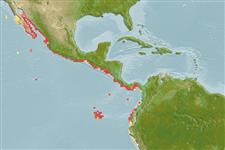>
Blenniiformes (Blennies) >
Blenniidae (Combtooth blennies) > Salariinae
Etymology: Ophioblennius: Greek, ophis = serpent + Greek, blennios = mucus (Ref. 45335).
Eponymy: Franz Steindachner (1834–1919) was an Austrian zoologist who specialised in herpetology and ichthyology. [...] (Ref. 128868), visit book page.
More on authors: Jordan & Evermann.
Environment: milieu / climate zone / пределы глубины / distribution range
экология
морской ассоциированный с рифами; пределы глубины 0 - 18 m (Ref. 5227). Tropical; 30°N - 10°S, 120°W - 70°W
Eastern Pacific: Bahía Sebastían Vizcaino and the northern Gulf of California (Isla Angel de la Guarda and Puerto Lobos) to Peru, including the Galapagos Islands (Ref. 5590).
Size / Вес / Возраст
половая зрелость: Lm ? range ? - ? cm
Max length : 18.0 cm SL самец/пол неопределен; (Ref. 28023); common length : 12.0 cm TL самец/пол неопределен; (Ref. 55763)
Краткое описание
определительные ключи | морфология | морфометрия
Body cylindrical; head with cirri above the eyes, on the nape, and at the posterior edge of the anterior nostril; maxillary not protrusible; each jaw with one row of incisiform teeth; anal and dorsal fins elongated ; lateral line divided into two, independent, overlapping segments (Ref. 55763).
Body shape (shape guide): fusiform / normal.
Adults prefer the surge zone of unprotected rocky headlands with steep slopes. They wedge themselves in crevices close to shore in shallow water, darting out to defend their territory. Diurnal feeders that graze on algae and sessile invertebrates, using their comb-like incisor teeth to scrape food (Ref. 28023). Oviparous. Eggs are demersal and adhesive (Ref. 205), and are attached to the substrate via a filamentous, adhesive pad or pedestal (Ref. 94114). Larvae are planktonic, often found in shallow, coastal waters (Ref. 94114).
Life cycle and mating behavior
половая зрелость | размножение | нерест | икра | Fecundity | личинки
Oviparous, distinct pairing (Ref. 205).
Thomson, D.A., 1987. Reef fishes of the Sea of Cortez. The rocky-shore fishes of the Gulf of California. The University of Arizona Press, Tucson. 302 p. (Ref. 5592)
Статус Красного Списка МСОП (Ref. 130435: Version 2025-1)
Угроза для людей
Harmless
Использование человеком
рыболовство: интереса не представляет; аквариум: коммерческий
дополнительная информация
инструменты
Специальные отчеты
Скачать в формате XML
ресурсы в Интернет
Estimates based on models
Preferred temperature (ссылка
123201): 20.3 - 29.1, mean 26.1 °C (based on 200 cells).
Phylogenetic diversity index (ссылка
82804): PD
50 = 0.5312 [Uniqueness, from 0.5 = low to 2.0 = high].
Bayesian length-weight: a=0.01000 (0.00529 - 0.01890), b=2.97 (2.81 - 3.13), in cm total length, based on LWR estimates for this species & (Sub)family-body (Ref.
93245).
Trophic level (ссылка
69278): 2.7 ±0.25 se; based on food items.
устойчивость к внешним воздействиям (ссылка
120179): средний (среднего размера), минимальное время удвоения популяции 1.4-4.4 года (Assuming tm=1 and Fec 100-1000).
Fishing Vulnerability (Ref.
59153): Low vulnerability (12 of 100).
🛈
Nutrients (Ref.
124155): Calcium = 82.9 [47.2, 125.0] mg/100g; Iron = 0.688 [0.441, 1.054] mg/100g; Protein = 18.7 [17.6, 19.6] %; Omega3 = 0.129 [0.087, 0.193] g/100g; Selenium = 22.1 [13.5, 38.2] μg/100g; VitaminA = 120 [41, 341] μg/100g; Zinc = 1.82 [1.31, 2.45] mg/100g (wet weight);
